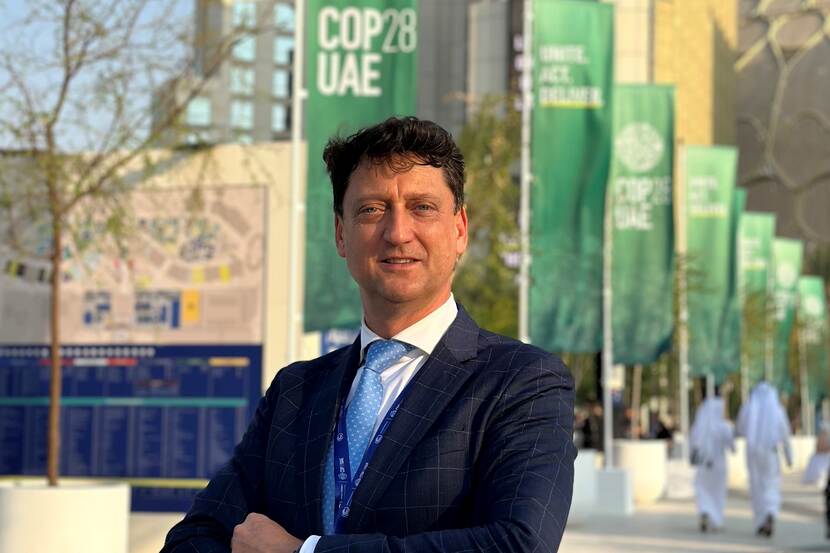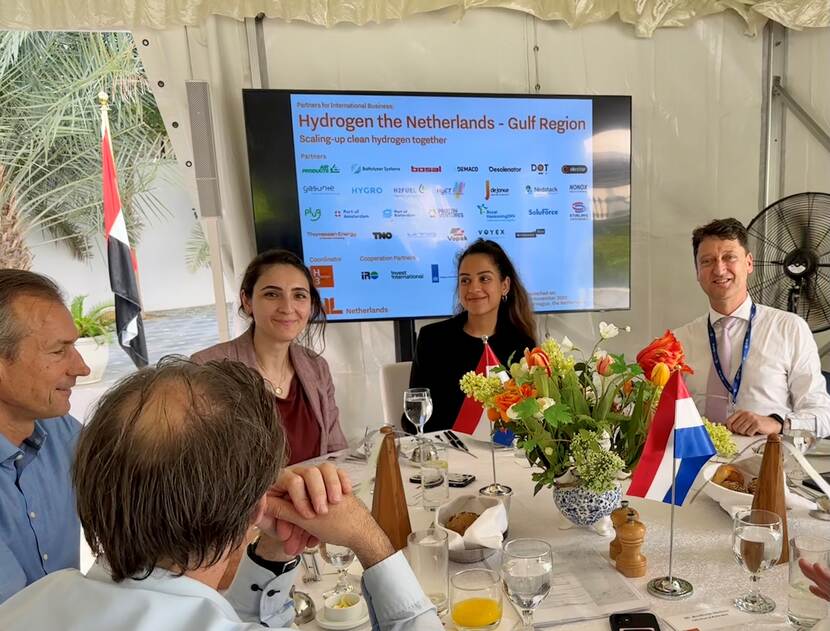Private sector playing central role at COP28: ‘We are in the middle of the energy transition, but we can’t just flip the switch.’
Weblogs
COP28 in the United Arab Emirates (UAE) is in full swing. At this major climate conference, which will end on 12 December, negotiations are taking place on all kinds of measures that should contribute towards slowing climate change. The private sector plays a crucial part in these talks.

The Netherlands and the UAE are working together to enable businesses to develop a whole range of climate projects. Edo de Ronde works at the Dutch Consulate-General in Dubai, where he represents our country as the executive director for the Middle East and North Africa of the Netherlands Foreign Investment Agency (NFIA). He tells us precisely how this collaboration with the UAE works.
What exactly is your job in Dubai?
‘I work for the NFIA,’ says Edo, ‘which is part of the Ministry of Economic Affairs and Climate Policy. We have an office in the Consulate-General in Dubai, but our work covers the whole of the– Middle East and North Africa – the MENA region. NFIA attracts valuable business activities from the region to the Netherlands, investing in particular in activities that can speed up the energy transition. Our main aim is to make our economy sustainable.’
How do the Netherlands and the UAE work together to find climate solutions?
Edo can give us several examples of successful collaboration between the two countries. ‘NFIA supports various projects run by the clean energy pioneer Masdar for example,’ he says. ‘That company is also known as the UAE’s green vehicle. It’s one of the world’s biggest investors in wind and solar energy.’
‘Masdar will also be one of the first players to export hydrogen,’ Edo continues. ‘We’re working very hard with the Dutch ports to bring this to the Netherlands. Investment in the infrastructure needed to import hydrogen to the Netherlands is one of the NFIA’s main focal points worldwide – not least because green hydrogen is one of our climate priorities.’
Collaboration between the two countries works both ways, Edo explains. ‘The Netherlands also shares its knowledge with the UAE and the rest of the MENA region. For example, we connect businesses here with knowledge institutions like TNO and Wageningen University, and support Dutch businesses wanting to bring their climate solutions to markets in the Middle East. Desolenator is a good example. They turn sea water into drinking water, making full use of solar energy. The Dutch embassy in Abu Dhabi and the Consulate-General in Dubai are supporting them with an international pilot project in Dubai.’
Like the Netherlands, the UAE is firmly committed to a successful energy transition. And both countries have the financial resources to invest in it. But that’s not the case for many middle-income countries in the MENA region, though they’re also keen to join the transition. What are the Netherlands and the UAE doing – either together or separately – to help these countries achieve their climate ambitions?
‘Both the UAE and the Netherlands have made funding available to various Global South middle--income countries in the MENA region – the Netherlands through Invest International and the Climate Fund Managers and the UAE with its own funds,’ Edo tells us. ‘Our NFIA office plays an active role in increasing projects’ feasibility by bringing parties and initiatives together. The aim of these projects is to generate renewable energy in these countries, enabling them to green their own economies and, in the longer term, to supply energy to other countries. We look forward to importing hydrogen from them.’
The UAE is hosting this year’s extremely important COP. How do you view the phasing out of fossil fuels in the private sector – a major worldwide priority?
‘It might seem contradictory, but fossil fuel companies are among the biggest investors in the energy transition,’ says Edo. ‘And we can’t yet manage without the fossil fuel industry. We’re in the middle of an energy transition, with the emphasis on transition. We can’t just flip the switch, because then we’d be sidelining a major part of the economy.’
The tide is turning in the discussion surrounding fossil fuel companies, says Edo. ‘At COP26 in Glasgow, they talked about the fossil fuel industry. Now the industry itself is taking part. That’s a good thing, because they’re also part of the solution.’
But we can’t take our foot off the electric accelerator just yet, he warns. ‘Governments worldwide must continue to put pressure on businesses to continue greening. At the same time, we have to make sure the Netherlands and Europe do not price themselves out of the world market. This COP can help us. I believe that the introduction of the European Emissions Trading System is a success in this regard. This system reduces CO2 emissions year by year, in line with the climate targets. And with the introduction of the Carbon Border Adjustment Mechanism (CRAM) we will prevent emissions being exported to countries outside the EU. Goods involving high levels of carbon emissions in their production process must become a whole lot more expensive, to reduce demand for them.’

Finally: what do you expect from COP28?
‘My main hope is that participants don’t just talk but also take action,’ says Edo. ‘On the very first day, the UAE and Germany each pledged to deposit $100 million in the loss and damage fund for countries contending with serious consequences of climate change. The EU followed suit by contributing $125 million. That was historic, and a good start. Let’s hope we have more successes this week and next.
‘The NFIA contributes among other things to programmes launched by the Netherlands’ special climate envoy, Invest International, the director-general for climate and energy at the Ministry of Economic Affairs and Climate Policy, and the ports of Rotterdam and Amsterdam. We’re also focusing on the construction of hydrogen corridors between the Middle East and the Netherlands by holding information sessions with government authorities and businesses from the UAE, Oman, Saudi Arabia and Egypt. We expect to take some real steps forward in achieving our aim of having terminals for green ammonia by 2027, and for liquid hydrogen not much later. The decisions to invest in these projects need to be taken now!’